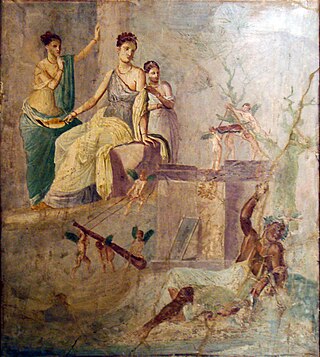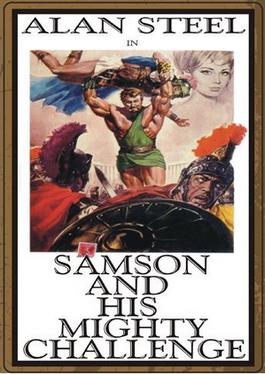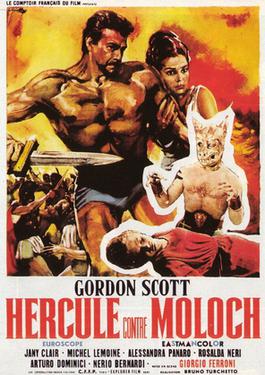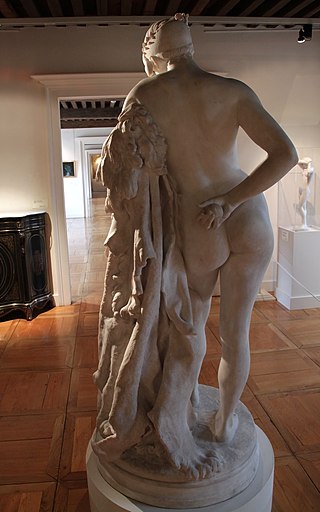
Hercules is the Roman equivalent of the Greek divine hero Heracles, son of Jupiter and the mortal Alcmena. In classical mythology, Hercules is famous for his strength and for his numerous far-ranging adventures.

In Greek mythology, Omphale was queen of the kingdom of Lydia in Asia Minor. Diodorus Siculus provides the first appearance of the Omphale theme in literature, though Aeschylus was aware of the episode. The Greeks did not recognize her as a goddess: the undisputed etymological connection with omphalos, the world-navel, has never been made clear. In her best-known myth, she is the mistress of the hero Heracles during a year of required servitude, a scenario that, according to some, offered writers and artists opportunities to explore sexual roles and erotic themes.

Antoine Hercule Romuald Florence was a Monegasque-Brazilian painter and inventor, known as the isolate inventor of photography in Brazil, three years before Daguerre, using the matrix negative/positive, still in use. According to Kossoy, who examined Florence's notes, he referred to his process, in French, as photographie in 1834, at least four years before John Herschel coined the English word photography.
Spiff and Hercules is a French comic strip titled featuring an anthropomorphic brown-yellow dog named Spiff and a black-white cat named Hercules, who, despite being best friends, are constantly fighting in a friendship/hate relationship. The character Spiff was created by José Cabrero Arnal for the French Communist Party newspaper L'Humanité on 28 March 1948 and the cat Hercules was introduced two years later. The characters' nemesis is Krapulax, who despite his infant-like features always has a diabolical plot in store.

Samson and His Mighty Challenge is a 1964 Italian sword-and-sandal film, released in 1965 at the very tail end of the peplum craze. Its original title was Ercole, Sansone, Maciste e Ursus gli invincibili. It is also known as Samson and the Mighty Challenge, Combate dei Gigantes, Triumph of the Giants or Le Grand Defi.

Hercules Unchained is a 1959 Italian-French epic fantasy feature film starring Steve Reeves and Sylva Koscina in a story about two warring brothers and Hercules' tribulations in the court of Queen Omphale. The film is the sequel to the Reeves vehicle Hercules (1958) and marks Reeves' second – and last – appearance as Hercules. The film's screenplay, loosely based upon various Greek mythology and plays by Aeschylus and Sophocles, was written by Ennio De Concini and Pietro Francisci with Francisci directing and Bruno Vailati and Ferruccio De Martino producing the film.

Port Hercules is the only deep-water port in Monaco. The port has been in use since ancient times. The modern port was completed in 1926, and underwent substantial improvements in the 1970s. It covers almost 40 acres (160,000 m2), enough to provide anchorage for up to 700 vessels. The port is located in the La Condamine district. Harbour pilots are required for all vessels longer than 30 metres. The depth of water in the harbour ranges from seven metres for standard berths and up to 40 metres for the outer piers and cruise ship docks.
Hercules and the Lost Kingdom is the second television movie in the syndicated fantasy series Hercules: The Legendary Journeys.

Nineteen ships of the French Navy have borne the name Hercule, in honour of the Roman hero Hercules:

Déjanire is an opera in 4 acts composed by Camille Saint-Saëns to a libretto in French by Louis Gallet and Camille Saint-Saëns. The last of Saint-Saëns' operas, it premiered on 28 August 1898 in the new arènes in Beziers. One of the opera's central characters, Hercule (Hercules), had been the subject of two earlier symphonic poems by Saint-Saëns – Le Rouet d'Omphale (1872) and La Jeunesse d'Hercule (1877). The story is based on The Trachiniae by Sophocles.
Hélène-Louise Demars (1736-1778) was a French composer and music teacher.

Hercule mourant is an opera by the French composer Antoine Dauvergne, first performed at the Académie Royale de Musique on 3 April 1761. It takes the form of a tragédie lyrique in five acts. The libretto, by Jean-François Marmontel, is based on the tragedies The Women of Trachis by Sophocles and Hercule mourant, ou La Déjanire (1634) by Jean Rotrou.
Le Rouet d'Omphale, Op. 31, is a symphonic poem for orchestra, composed by Camille Saint-Saëns in 1871. It is one of the most famous of the four symphonic poems in a mythological series by Saint-Saëns. The other three in the series are Danse macabre, Phaëton, and La jeunesse d'Hercule.

Hercules's Dog Discovers Purple Dye or The Discovery of Purple by Hercules's Dog is an oil painting by Flemish artist Peter Paul Rubens painted circa 1636, towards the end of his career. It depicts the mythical discovery of Tyrian purple by Hercules and his dog, and was one of dozens of oil on panel sketches made by Rubens for the decoration of the Torre de la Parada in Spain. A completed painting based on Rubens's sketch was made by Theodoor van Thulden in 1636–1638, and is now held by the Prado Museum.
Jean-Pierre Brulois is a former world champion powerlifter, strongman and Olympic Weightlifter from France

Hercules vs. Moloch is a 1963 Italian/French international co-production peplum film written and directed by Giorgio Ferroni and starring Gordon Scott. The film reuses battle scenes from Ferroni's 1961 film The Trojan Horse.

Astarté is an opera in four acts and five scenes by Xavier Leroux to a libretto by Louis de Gramont. It was premiered at the Opéra de Paris on 15 February 1901, directed by Pedro Gailhard.

Hercules and Omphale is an oil-on-canvas painting by François Boucher, painted in 1732–1734 and now in the Pushkin Museum in Moscow. It was in the Yusupov collection in Saint Petersburg until 1930. It dates to the period just after Boucher completed his studies with François Lemoyne.

Omphale is a marble sculpture by the French artist Jean-Léon Gérôme, made between 1886 and 1887, and now kept in the Musée Georges-Garret in Vesoul. A pencil sketch of the work is kept at the Dallas Museum of Art.














